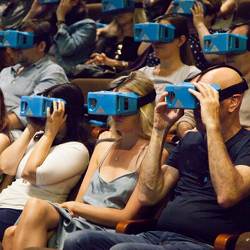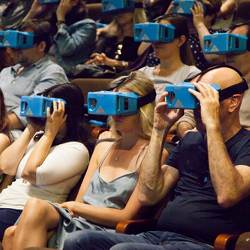
In May, Santa Clara, CA, played host to the ninth annual Augmented World Expo, a conference and showcase for augmented reality (AR) and virtual reality (VR) technologies that has been held since the iPhone 4 was new.
AR generally refers to the addition of digital information to a view of the real world, while VR creates an immersive, entirely manufactured world.
In its early years, the Expo consisted almost entirely of flashy demos of standalone products. Today, the field has matured to the point where presenters discuss successful implementations and gave advice on good content. While millions of viewers have experienced the potential of AR in the form of digital first-and-ten lines displayed on TV screens during football games or lights trailing pucks in hockey broadcasts, AR that individual consumers can invoke and control themselves is still rare.
Will new applications like virtual travel and augmented restaurant menus make VR and AR a part of everyday life?
"VR and AR, together with AI (artificial intelligence), are the three legs of the next technology cycle," says Lyron Bentovim, CEO and president of The Glimpse Group, which comprises several VR and AR startups. "But we're very early in that cycle; it'll probably be seven to 10 years before we get mass adoption of these technologies."
A year ago, market research firm Gartner identified AR as being in the "Trough of Disillusionment" portion of its Hype Cycle for Emerging Technologies, 2017, estimating it would be five to 10 years before AR reaches the "Plateau of Productivity." The market researcher suggested VR is further along, on the upswing of the "Slope of Enlightenment" that will lead to the "Plateau of Productivity" within two to five years.
According to Rick Veague, chief technology officer at enterprise business application provider IFS North America, the most fully realized implementations of either technology at present are those used for maintenance and repair of complex machinery, "because they're the most readily understood." The same goes for assembly of such assets: for example, aerospace manufacturer Boeing, which has been experimenting with AR for nearly 30 years, provides employees with a custom headset that will display images of relevant parts, along with step-by-step instructions for the assembly of satellite panels.
However, says Cindy Mallory, co-chair of the Location-Based Entertainment committee of the VR/AR Association, a St. Louis, MO-based "global member community of the best minds in virtual reality an augmented reality," while businesses cautiously embrace these technologies, they have been slow in coming to average consumers. "There are too many barriers to entry, I think, for people at home to be using it," Mallory says. Mobile AR and VR will change that, she says, "because it's something people already have in their hands." referring to Apple's ARKit and Google's ARCore, built into the latest versions of their iOS and Android smartphone operating systems respectively, which have created a vast pool of AR-enabled users.
AR for commerce, AR for art
So where are consumers likely to encounter personal, non-broadcast AR content?
Glimpse Group's subsidiary Kabaq creates digital equivalents of the restaurant dessert cart, with which a restaurant entices diners to order by showing them how good the food looks. "We take a few hundred high-resolution pictures of a dish prepared by a chef and convert them into one high-quality 3D (three-dimensional) asset," says Bentovim. "Then we take that asset and project it in front of you." Using their smartphones, diners can visualize the food sitting on their tables, adding visual appeal to the menu description. Bentovim says one client that used the technology saw dessert revenue climb 30% in the first month.
Thomas Ortega, owner of Omega Ortega, a consultancy and application development firm based in Queen Creek, AZ, is working with financial institutions on augmented mailers. "Banks for years have given out mailers, fliers, and other such items," he says. "We're augmenting additional data on top of them." Ortega describes the possibility of a holiday mailer that, when viewed through a bank's app, would greet the customer by name and display information such as advice for buying holiday presents on a budget.
Augmented reality is finding its place in the arts as well.
In May, Cuseum, a Boston startup that develops AR apps for museums that supplement the museum-going experience, created an AR version of Gustav Klimt's Tree of Life. Using iPads, visitors to Vienna's Museum of Applied Arts (home of the original painting) could walk around the tree as though it were standing on the museum's lawn.
In June, Tel Aviv-based ARShow debuted a live theater performance in which the audience wore headsets containing smartphones that displayed the actors on stage, along with additional digital content with which the audience could interact via a switch on the headset.
Total immersion
Developers are exploring new applications for VR as well. One implementation attracting a lot of attention is telepresence, which lets people in different places interact with moving, talking virtual models of each other.
Microsoft, for example, has been working on a technology it calls Holoportation, which bridges VR and AR. Holoportation uses photo capture to create a 3D model of a person, which is then transmitted to someone wearing the company's HoloLens or some other display device. That second person can interact with the first person's "hologram" as though they were really present.
Similarly, the Glimpse Group is working with the Montefiore Medical Center in the Bronx, NY, on a Holoportation-style project to ease a child's hospital stay. The company can scan the child's parents and produce virtual copies that the child can interact with when the parents can't be there in person.
VR is also finding a role in architecture and space planning. InsiteVR is a New York-based company that provides cross-platform VR meeting software that gives architects and project managers a way to "build a structure in virtual reality, have the meetings, change everything in the virtual model before they even break ground," says Mallory.
Likewise, Microsoft Layout software designing workspaces in three dimensions is compatible with both the HoloLens and the Windows Mixed Reality immersive headset, and allows users to import 3D models of furniture and equipment and either visualize them in real space or place them in virtual space, collaborating as required.
Future possibilities
As with any new technology, consumers' increasing comfort and familiarity with VR and AR will have ripple effects on their behavior and expectations. "I think there are two killer apps that will change our lives," says Glimpse Group's Bentovim. "The first one will be the virtual office." Bentovim sees a time when a company will have one virtual office, shared by all its employees around the world. As companies embrace this model, it will lead to increased availability and miniaturization of headsets across the board.
VR will also transform travel, Bentovim believes. "You will be able to virtually travel anywhere, with anyone you want, for a short period of time." Not only will this eliminate the need for a lot of physical travel, he suggests, but it will give people the chance to travel together to historical or even fictional places. "Spending social time with your friends and family in all these worlds will be a big changer of how we spend our leisure time."
Ortega points out that new technology creates new expectations. "When I rent a car, I want to know which models have CarPlay so my iPhone can work with their stereo," he says. "I'd like to be able to view the cars on the lot through the agency's app on my phone and see their features called out in real time." Alternatively, looking at a car through an auto sales app could supply a range of list prices, he suggests, while viewing through a bank app could offer loan rates and other terms. Consumers will come to expect access to that level of information on demand.
The true potential of AR and VR will be unlocked, say Veague and Mallory, when they are combined with other technologies. "It isn't the technology that makes the breakthrough," says Veague, "it's combining multiple technologies into a holistic plan and set of tools to achieve an objective." He describes a scenario in which Internet of Things (IoT) sensors provide real-time information on the behavior of an asset in the field, while an AI analysis diagnoses the reason for some observed behavior, and AR glasses deliver repair instructions to the field technician.
"We're moving towards a digital integrated mesh," says Mallory. "Looking into the future, I imagine a visor that can go opaque or transparent—VR-immersive or AR-overlay—that will be connected to everything."
Yet such a connected virtual future could have its dangers, Mallory warns. "One of the scary things about that is how advertising is going to be moderated in the virtual space; will advertisers be able to insert objects into your virtual space?
Another issue that will need to be nailed down is who owns the rights to your digital image. "With volumetric capture, you can make it look like any celebrity is actually speaking," she says. "If somebody creates a replica of you in VR, are they allowed to use it as they want, or do you own that?"
Jake Widman is a San Francisco, CA-based freelance writer focusing on connected devices and other developing technologies.




Join the Discussion (0)
Become a Member or Sign In to Post a Comment